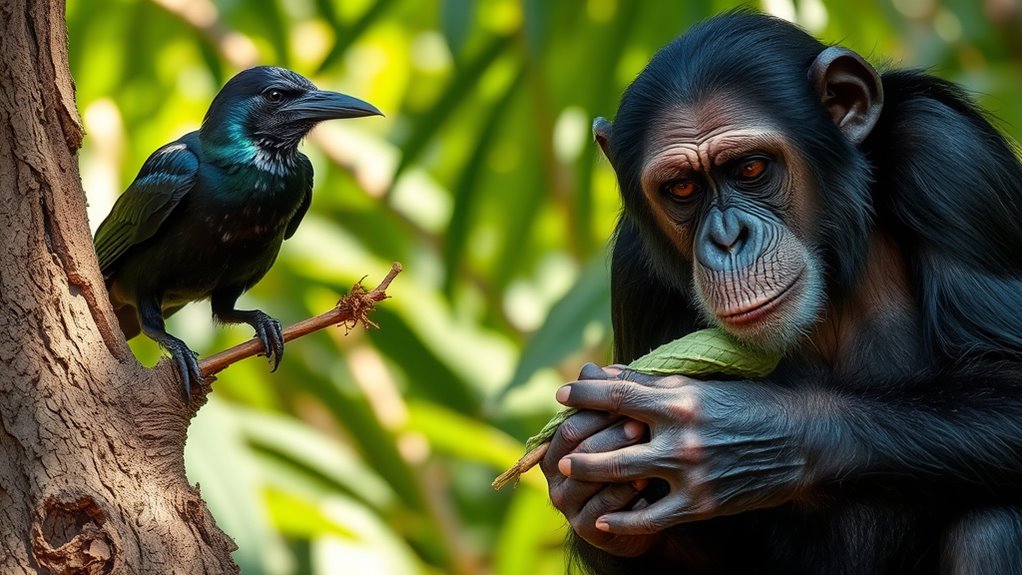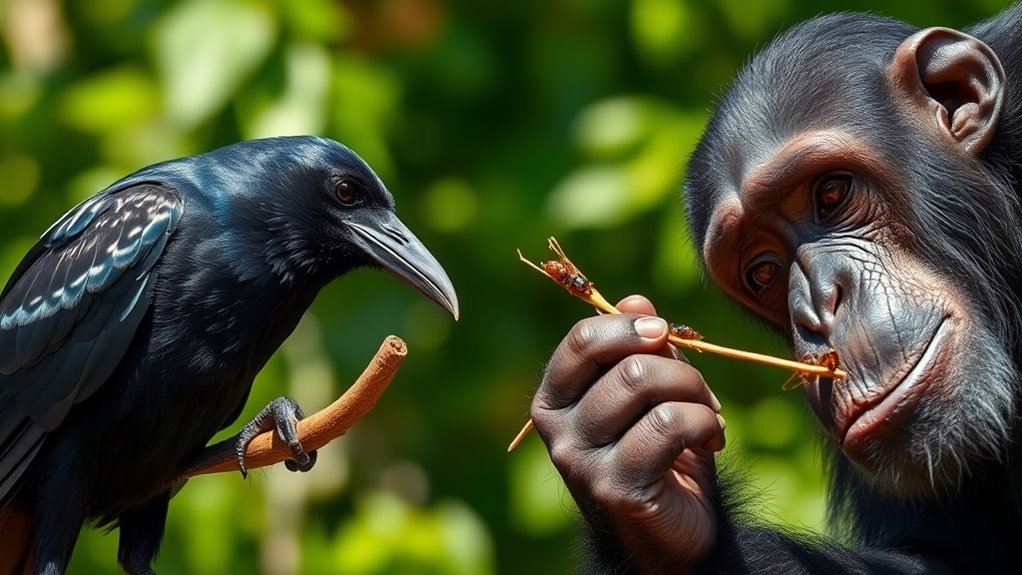Animals like crows and chimpanzees show incredible creativity in using tools. Crows bend twigs to create hooks, while chimpanzees learn to fish for termites by watching others. This tool use highlights their advanced problem-solving skills and social learning. Dolphins also exhibit this behavior, passing sponge-foraging techniques through generations. Elephants use branches for various tasks, demonstrating innovation. There’s so much more to discover about how these species adapt and thrive through their unique abilities.
Key Takeaways
- Crows demonstrate tool-making by bending twigs to create hooks for extracting insects, showcasing their cognitive abilities.
- Chimpanzees utilize sticks for termite fishing, learning through observation and social learning from experienced individuals.
- Dolphins protect their snouts with marine sponges while foraging, indicating adaptability and innovative problem-solving.
- Elephants use branches to swat flies and dig for water, demonstrating environmental adaptation through tool use.
- Cultural transmission of tool use behaviors enhances survival rates and social learning within animal groups, reflecting complex cognitive evolution.

While many people think tool use is a uniquely human trait, you’ll be surprised to learn that various animal species also demonstrate this remarkable skill. Take crows, for instance. These birds have shown incredible ingenuity, using sticks to extract insects from tree bark or bending twigs to create hooks. Their ability to fashion tools isn’t just instinctive; it’s a result of cognitive evolution that showcases their problem-solving skills. Crows can learn from each other, which brings us to another fascinating concept: cultural transmission.
Tool use isn’t exclusive to humans; crows exemplify remarkable ingenuity and cognitive evolution in their problem-solving abilities.
You might wonder how cultural transmission plays a role in tool use among animals. Well, it’s simple. Just as humans learn skills from one another, animals do the same. Research has shown that young chimpanzees learn to use sticks for termite fishing by observing their elders. This kind of learning is vital for the survival of these species. If a young chimpanzee didn’t learn the technique, it might struggle to find food, which highlights the importance of sharing knowledge. This cultural exchange enriches their social structure and enhances their survival rates.
Dolphins also exemplify tool use, particularly when it comes to foraging. They’ve been observed using marine sponges to protect their snouts while searching for fish on the seafloor. This behavior is taught and passed down through generations, illustrating yet another example of cultural transmission in the animal kingdom. Just like with crows and chimpanzees, dolphins’ tool use reflects their cognitive evolution and adaptability to their environment.
Even elephants have been known to use tools, such as branches to swat flies or even dig for water during dry spells. Their ability to innovate and use tools to solve problems is a proof of their intelligence. Like other species, they also rely on learning from their peers, showcasing that the knowledge of tool use can be shared within their social groups. Moreover, adaptive learning technologies can be observed in how these animals develop their tool use skills through interaction and experience.
Frequently Asked Questions
What Are the Most Surprising Examples of Tool Use in Animals?
You might be surprised to learn that octopuses use coconut shells for shelter and protection, showcasing impressive animal cognition. Sea otters use rocks to crack open shellfish, demonstrating their problem-solving skills. Even some birds, like the New Caledonian crow, craft tools from twigs to extract insects. These behaviors provide evolutionary advantages, allowing animals to adapt to their environments and access resources more efficiently, highlighting their intelligence and adaptability in the wild.
How Do Animals Learn to Use Tools Effectively?
Animals learn to use tools effectively through a learning process that involves observation, trial and error, and imitation. You might notice that young animals often watch adults, picking up skills as they see others succeed or fail. This cognitive development allows them to understand the relationship between the tool and its purpose. Over time, they refine their techniques, adapting their approaches based on experience and environmental challenges, enhancing their problem-solving abilities.
Are There Any Benefits to Tool Use for Animal Survival?
Absolutely, tool use offers significant survival advantages for animals. When you observe species that utilize tools, you’ll notice they can access food more efficiently, defend themselves, and build shelters. These tool use benefits enhance their ability to adapt to changing environments and overcome challenges. By using tools, animals can exploit resources that would otherwise be out of reach, ultimately increasing their chances of survival in the wild.
Do All Animals Have the Capability to Use Tools?
Not all animals have the capability to use tools. For instance, while some birds like crows demonstrate remarkable problem-solving skills, others lack this ability entirely. Tool use often hinges on cognitive abilities, where innate traits meet learned behaviors. You might see a monkey using a stick to extract termites, showcasing both instinct and learning. This blend of innate and learned skills sets apart those who can innovate versus those who can’t.
How Does Tool Use Vary Across Different Animal Species?
Tool use varies considerably across species, reflecting their specific behaviors and evolutionary adaptations. For instance, some birds, like crows, craft tools for foraging, showcasing advanced problem-solving skills. In contrast, primates like chimpanzees utilize tools for tasks such as cracking nuts, demonstrating their dexterity and intelligence. These differences arise from each species’ unique environment and survival needs, shaping how they interact with their surroundings and utilize available resources.
Conclusion
From the clever crows that craft tools with precision to the insightful chimpanzees that use sticks to extract termites, the animal kingdom showcases a remarkable spectrum of intelligence. While some species rely on instinct alone, others demonstrate innovation, bridging the gap between instinct and intellect. This juxtaposition highlights not just the complexity of animal behavior, but also challenges our understanding of what it means to be intelligent. Ultimately, tool use in animals invites us to rethink the boundaries of cognition.










